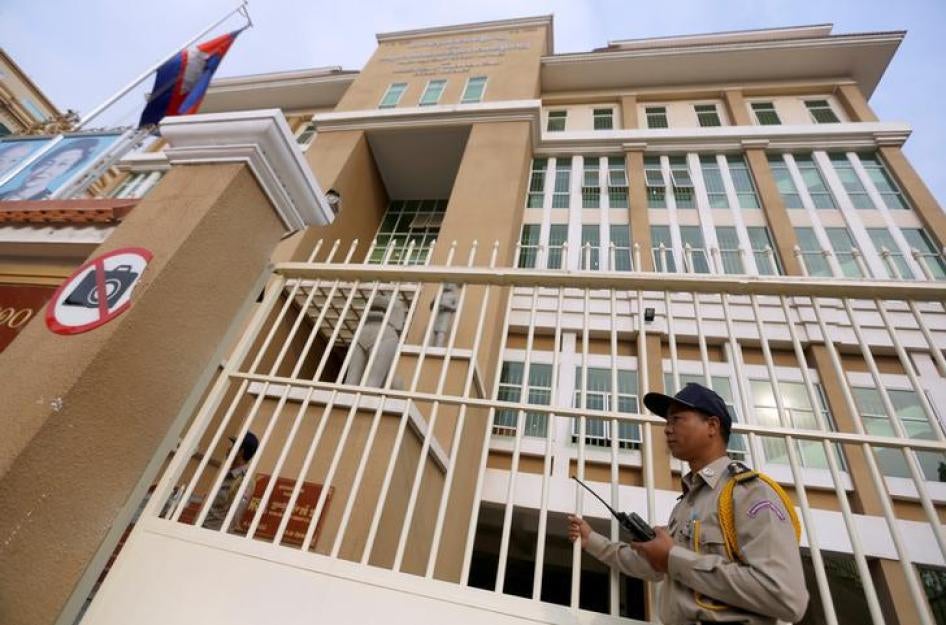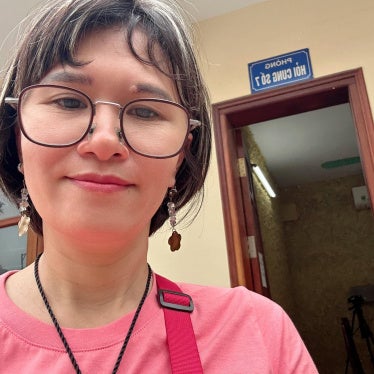(Phnom Penh) - Cambodia should continue to investigate the killing of prominent political commentator Kem Ley in order to address key aspects of the case that appear to have been inadequately investigated, said the International Commission of Jurists (ICJ), Amnesty International, and Human Rights Watch today.
On 23 March 2017, the Phnom Penh Municipal Court found Oeuth Ang guilty of the premeditated murder of Kem Ley on 10 July 2016 and sentenced him to life imprisonment. Prior to the half-day trial, which took place on 1 March 2017, the authorities released almost no information about the investigation.
“The trial revealed that the investigation appeared to be deficient in several important respects,” said Kingsley Abbott, Senior International Legal Adviser at the International Commission of Jurists who observed the trial. “Until there is an independent, impartial and effective investigation to establish whether anyone else was involved in the killing, the victims of this serious crime, including Kem Ley’s wife and children, will be unable to obtain justice.”
Even the very identity of the defendant was at issue. At trial, Oeuth Ang maintained he is 39-years-old, unmarried, and named “Chuob Samlab” - which translates in English as “Meet to Kill” - from Banteay Meanchey province. However, the prosecutor submitted that based on the fingerprint on the ID card of Oeuth Ang, he is satisfied that the defendant is in fact Oeuth Ang, married, born in 1972, from Siem Reap province.
“The proceedings may have established that Oeuth Ang pulled the trigger, but the investigation does not seem to have considered whether someone else loaded the gun”, said Champa Patel, the Amnesty International Director for Southeast Asia and the Pacific. “It is clear that the authorities want to close the book on this case and move on but failures in the investigation of this heinous act can only serve to compound the injustice already suffered by the family of Kem Ley”.
The hearing commenced at 8:40 and concluded at 13:00. After Oeuth Ang gave evidence, ten witnesses gave oral testimony including two Caltex workers, seven officials who were involved in the investigation in different capacities, and a doctor who examined Kem Ley’s body at the scene of death. Official reports and the statements of several witnesses were also read into evidence, and the prosecution played eight videos from different locations, including one captured by a closed circuit television (CCTV) camera inside the Caltex station where Kem Ley was killed. Kem Ley’s widow, who was named as a civil party, did not appear at the trial but her civil party statement was read into evidence.
“The authorities’ failure to investigate so many clear gaps in the defendant’s story and the court’s unwillingness to examine them suggest that a quick conviction rather than uncovering all involved was the main concern,” said Phil Robertson, Deputy Asia Director at Human Rights Watch. “Kem Ley’s family have been outspoken in their disbelief that Oeuth Ang was solely responsible for the murder, and the trial’s conduct lends credence to their skepticism.”
Eight issues that were not adequately addressed at trial
While at trial Oeuth Ang testified that he killed Kem Ley over a USD $3,000 debt and acted alone, the prosecution's presentation of the case – which is the only publicly accessible record of the investigation - appeared to reveal significant gaps in the investigation’s attempt to establish the truth, including:
- Oeuth Ang claimed he had the means to provide Kem Ley with $3,000 because he had sold a parcel of land he had possessed since he was young. However, the prosecutor did not outline any efforts investigators had taken to verify this part of Oeuth Ang’s story, for example locating the land, obtaining any proof of ownership or sale, or interviewing the alleged purchaser to verify that the sale took place. No statement from the alleged purchaser was produced at trial and no one appeared as a witness on this issue. The results of any financial or telecommunication inquiries, on any issue, were not produced at trial either.
- Oeuth Ang claimed he met Kem Ley only once in Phnom Penh after being introduced to him by an intermediary named “Pou Lis”. At this meeting, he claimed he provided Kem Ley with $3,000 in exchange for the promise of a house and employment. However, the prosecutor did not outline any attempts investigators had made to identify, locate and interview Pou Lis. No statement from Pou Lis was produced at trial and he did not appear as a witness.
- The Prosecutor played video footage from only one CCTV camera from inside the Caltex station where Kem Ley was killed. The prosecutor claimed the video showed Oeuth Ang entering the station before allegedly killing Kem Ley. Kem Ley could not be seen in the frame of the video. While the Caltex station appears to have numerous CCTV cameras installed, including on the forecourt, the prosecutor did not outline what video footage investigators had been able to obtain from the different Caltex cameras, and provided no explanation for only playing footage from one Caltex camera. This information could potentially be relevant to several issues, including whether Oeuth Ang acted alone, by shedding light on his movements before, during, and after the killing.
- The Caltex CCTV footage played at trial showed a man in a white shirt sitting with Kem Ley shortly before he was shot. No evidence was produced showing whether investigators had attempted to identify the man and he was not called as a witness during the hearing.
- Oeuth Ang claimed someone whom he did not see fired a weapon at him while he was fleeing the crime scene. The prosecutor did not address this issue adequately, including whether any attempts had been made to identify and interview the alleged shooter. No statement from the alleged shooter was produced at trial and they did not appear as a witness.
- Oeuth Ang claimed he bought a Glock handgun he says he used to kill Kem Ley from an acquaintance in Thailand named “Chork”. The prosecutor did not outline any efforts that had been made, if any, to identify, locate and interview Chork. No statement from Chork was produced at trial and he did not appear as a witness.
- It is unclear what steps were made during the investigation to confirm important elements about Oeuth Ang’s background, including any links to military or official roles he has held in the past. According to statement of the defendant’s wife, who was not present at the hearing, Oeuth Ang was formerly a Khmer Rouge soldier. A statement by his mother, who was also not present during the proceedings, outlined that Oeuth Ang had worked for the “Environmental Department.” At trial, Oeuth Ang stated that he had previously worked as a chef for soldiers but denied that he had been a soldier. He also maintained that he was named “Chuob Samlab” and was not known by another name.
- At trial, the prosecutor played a series of eight videos from different vantage points showing the man alleged to be Oeuth Ang fleeing the crime scene and running eastwards up Mao Tse Tung. These videos, which were also published on a government aligned news website on the day of the trial, revealed that several vehicles, among them, a white SUV and two motorcycles, appear to have followed the fleeing man. A man seen riding pillion on one of the motorcycles appears to be holding an assault rifle. The identity of these vehicles and men were not referred to during the trial and none of them was called as a witness.
Background
During the morning of 10 July 2016, Kem Ley was shot and killed at a petrol station cafe on Phnom Penh’s Monivong Boulevard. Police arrested Oeuth Ang a short time later while fleeing the scene. According to police, he later “confessed” to the killing claiming his motive was an unpaid debt of $3,000 Kem Ley owed him, a claim disputed by Kem Ley’s widow and Oeuth Ang’s wife.
Kem Ley’s killing occurred against a backdrop of escalating attacks on human rights defenders and the political opposition and Cambodia’s well-documented history of killings which are alleged to have had state involvement.
On 13 July 2016, shortly after the killing, the ICJ made five concrete recommendations to the Cambodian authorities aimed at meeting its obligations under international law to promptly carry out an independent, impartial and effective investigation into the killing.
On 23 March 2017, the Phnom Penh Municipal Court found Oeuth Ang guilty of premeditated murder (Article 200 of the Cambodian Criminal Code) and the unauthorized holding or transporting of weapons (Article 490 of the Cambodian Criminal Code).
Today, it was reported in the media that, following the verdict, Oeuth Ang’s lawyer told journalists the court had created a new case-file to investigate two men named Pou Lis and Chak who may be relevant to the killing of Kem Ley. This statement has yet to be officially confirmed and no further details of the identity of the men or how they may be related to the case has been made available.
Pursuant to international law binding on Cambodia, including the International Covenant on Civil and Political Rights (ICCPR) to which Cambodia is a State Party, Cambodia has a duty to promptly, independently, impartially, and effectively investigate all deaths suspected of being unlawful. Investigations must seek to identify not only direct perpetrators but also all others who may have been responsible for criminal conduct in connection with the death.









